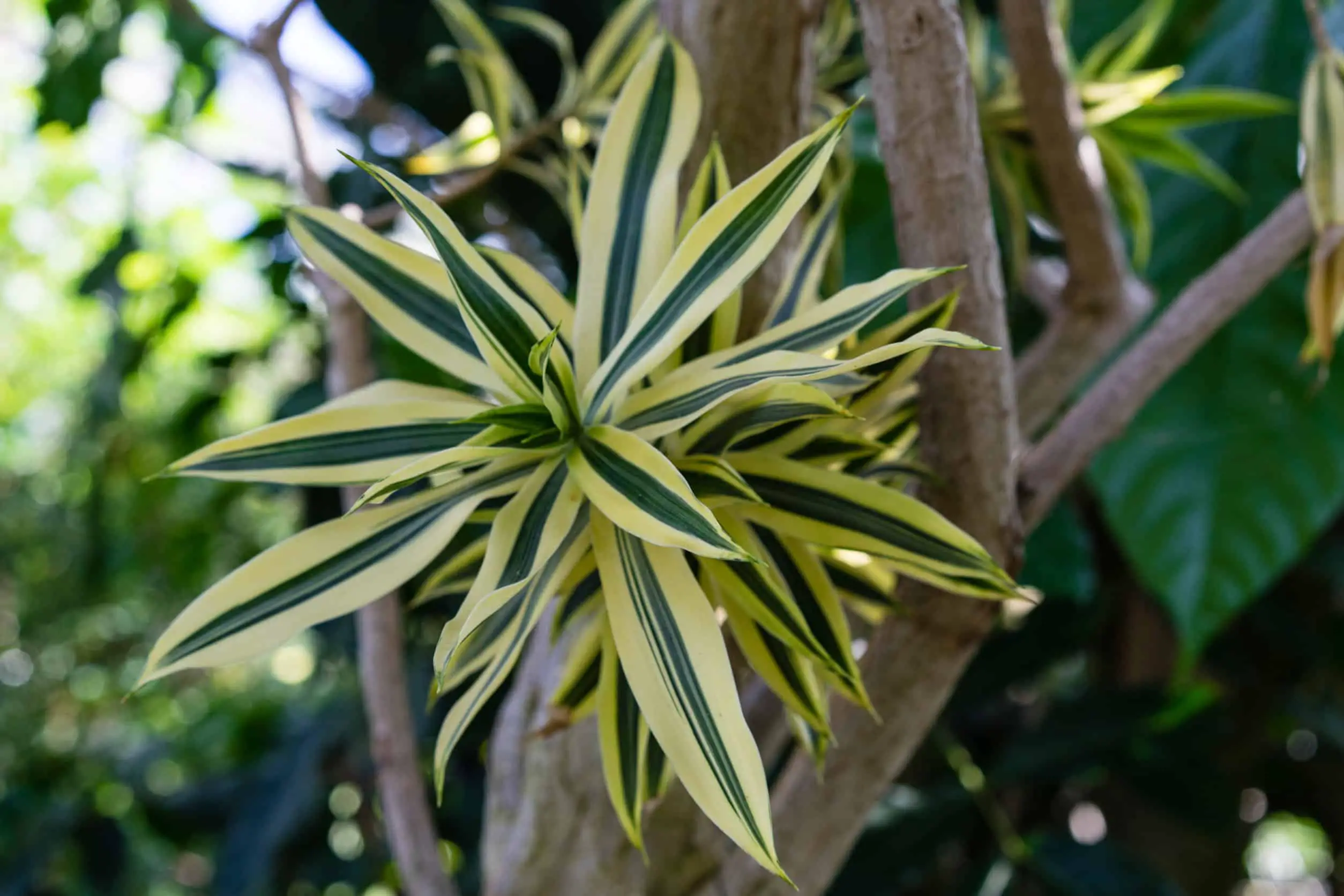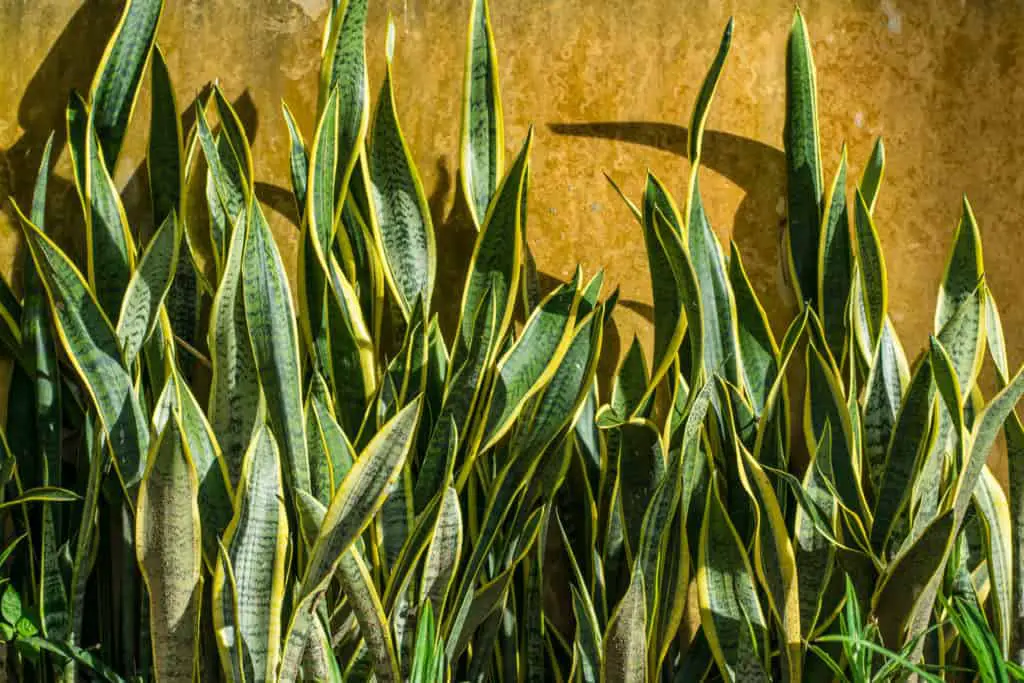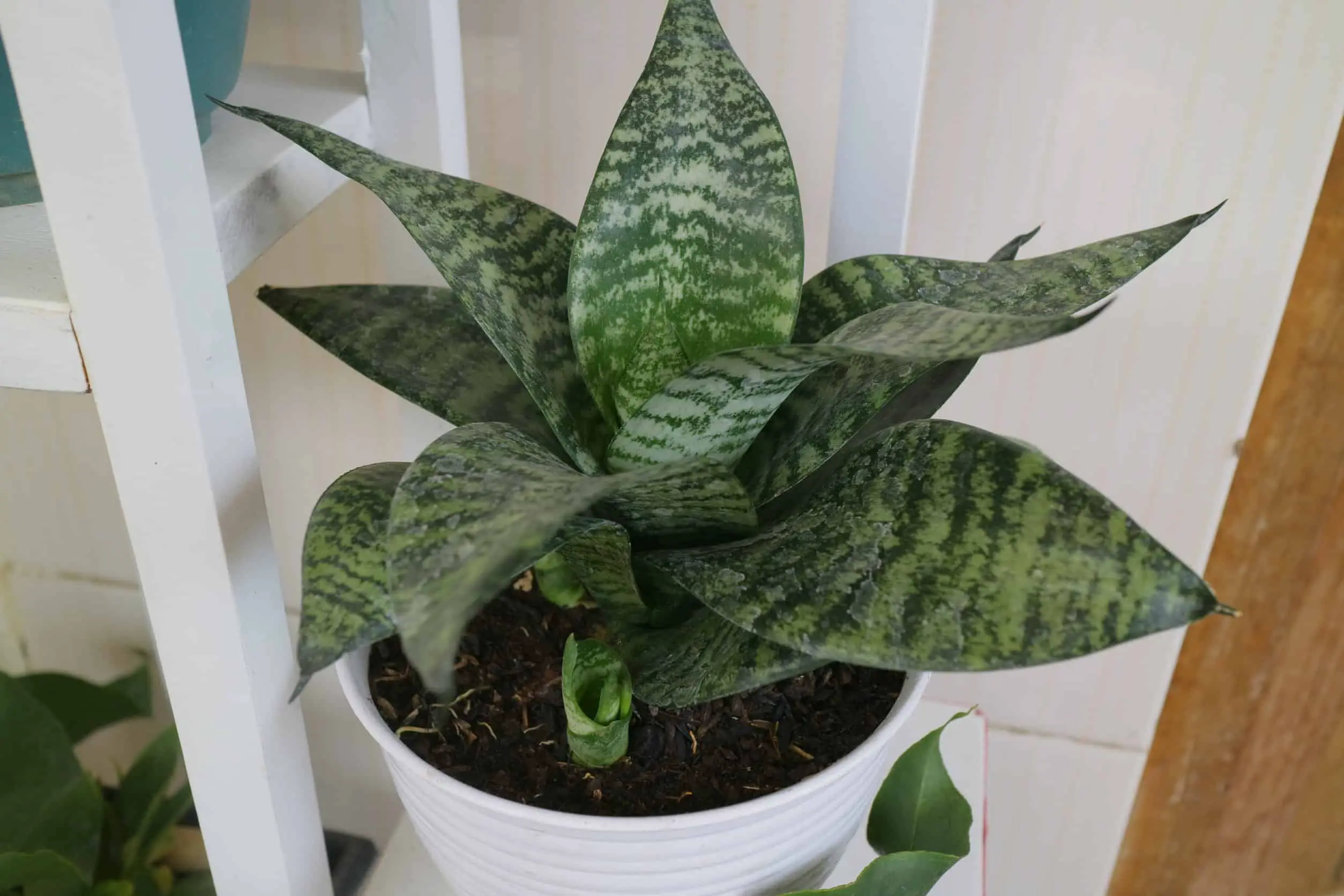
Dracaenas are a beginner gardener’s best plant friend. These tropical houseplants are one of the easiest to care for indoors. If you’re looking to find one that is perfect for you, then you’ve come to the right place!
Here’s a list of Dracaena varieties for you to browse through:
(As an Amazon Associate, I earn from qualifying purchases.)
Table of contents
1. Dracaena Fragrans/Deremensis (Corn Plant)

True to its name, this particular dracaena does resemble a cornstalk. The dark, lustrous green leaves are arranged on the cane-like stems in an unfurling outward manner. But don’t be fooled; you won’t find any corn hiding in between the foliage.
What are its basic care needs?
- Sun: Dappled shade; all day exposure to indirect sunlight, away from direct sun.
- Soil: Fertile, loamy, consistently moist soil.
- Water: Once a week or when the top 1-2 inches of the soil dry out.
- Fertilizer: Monthly feeding using diluted liquid fertilizer.
- Temperature & Humidity: 65-75°F/18-24°C at 50% humidity levels.
- Special care:
- Prune the plant at your desired height in spring if it’s getting too tall for your liking.
- Repot the plant every 2-3 years as it develops bigger.
What are some of its known cultivars?







- Janet Craig
- Prominent features: This plant can reach up to 10 feet tall.
- Warneckii
- Prominent features:
- It is known for its variegated leaves, i.e., striped dark green and white.
- It can also grow up to 10 feet tall.
- Prominent features:
- Mass Cane/Massangeana
- Prominent features:
- It has dark green leaves with a broad, central yellow stripe.
- It has a growing range of 5-15 feet tall in height.
- Special note on its basic care:
- It can tolerate growing in any soil type but prefers fertile, loamy soil.
- Prominent features:
- Limelight
- Prominent features:
- It has distinctive shiny, lime green leaves.
- This plant can only grow up to 5 feet tall.
- Prominent features:
- Lemon Lime
- Prominent features:
- This plant has an intriguing surrounding chartreuse color, followed by a thin, cream line bordering a dark green central stripe.
- It can grow anywhere from 5 to 10 feet tall.
- Prominent features:
- Compacta
- Prominent features:
- It has a mature height of 5 feet tall, making it the smallest corn plant cultivar on the list!
- Special note on its basic care:
- It prefers fertile, loamy soil that is slightly acidic at pH 6.1-7.
- It should only be fertilized twice a year in spring and summer using slow-release fertilizers.
- It can tolerate a temperature of 60-75°F/16-24°C at 25-40% humidity levels.
- Prominent features:
- Bausei
- Prominent features:
- It has shiny, dark green leaves with a lovely white streak center.
- It can grow anywhere from 4 to 15 feet tall.
- Prominent features:
If you have a problem with your particular Corn Plant, you can read more on how to handle it in this article.
2. Dracaena Reflexa/Pleomele

It may be no surprise to know that these plants are a favorite in most homes because of their striking leaf colors arranged irregularly on their sizable stems. It also has an irregular bent shape to its leaves, which sometimes reminds me of a pinwheel toy. It’s not as fun or interactive as the nostalgic toy, but its presence is nonetheless aesthetically pleasing.
What are its basic care needs?
- Sun: Plenty of bright indirect sunlight, away from direct sun.
- Soil: Fertile, loamy, well-draining soil.
- Water: Every 3-4 days when the top 1-2 inches of the soil dry out.
- Fertilizer: Monthly feeding from spring to summer using diluted liquid fertilizers.
- Temperature & Humidity: 60-80°F/15-27°C at 50% humidity levels.
What are some of its known cultivars?


- Song of India
- Prominent features:
- The leaves have creamy-white borders encompassing a central, dark green streak.
- It can grow anywhere from 3 to 6 feet tall.
- Prominent features:
- Song of Jamaica
- Prominent features:
- It is distinctly variegated, i.e., the leaves are striped with chartreuse, cream, and deep green streaks.
- It has a mature height of 10 feet tall.
- Prominent features:
3. Dracaena Surculosa/Godseffiana (Spotted/Gold Dust Dracaena)

You’d be an extremely lucky person to be able to find this dracaena plant. It’s hard to find these days, and for good reasons too! Compared to the other dracaena varieties, this plant has a fascinating splotches-filled look to its leaves. It may look like someone splattered light yellow or cream paint against the dark leaves of the plant, but its chaotic, abstract beauty is what makes it so coveted!
What are its basic care needs?
- Sun: Plenty of bright indirect sunlight, away from direct sun.
- Soil: Fertile, loamy, consistently moist soil.
- Water: Every 3-4 days when the top 1-2 inches of the soil dry out.
- Fertilizer: Monthly feeding using diluted liquid fertilizer.
- Temperature & Humidity: 65-75°F/18-24°C at 50% humidity levels.
Any precautions to growing this dracaena plant? Because of its unique splotches look, it is a bit fussy about its light needs:
- If the leaves are browning or dropping, it’s likely to be receiving too much light. Move it to a more shaded location to let it recover.
- If the leaves are losing color, it’s not receiving enough light. Inch it into a brighter spot a day at a time; this will let it gradually ease into its new sunny environment.
What are some of its known cultivars?


- Florida Beauty
- Prominent features:
- Its leaves are known to be one of the most spotted of all cultivars.
- It can grow anywhere up to 2 to 3 feet tall.
- Prominent features:
- Kelleri
- Prominent features:
- The leaves are significantly thicker than most cultivars of this variety.
- Prominent features:
4. Dracaena Trifasciata (Snake Plant)

You probably know this plant already and didn’t expect it to be a dracaena plant at all. To be fair, botany is still a mess, and they are forever changing their minds about which plant belongs to which family. But I digress.
Known for its hardiness and resilience, you can’t really go wrong having this plant around if you’re a total newbie. In fact, the more you neglect it, supposedly you’re giving it the chance to bloom indoors. Personally, I haven’t tried it but let me know down in the comments or send me an email if you’ve ever experienced it!
What are its basic care needs?
- Sun: Plenty of bright indirect sunlight, away from direct sun.
- Soil: Fertile, loamy, well-draining soil.
- Water: Once every 1-2 weeks when the soil completely dries out.
- Fertilizer: Monthly fertilizer in spring and summer using an all-purpose fertilizer at half strength.
- Temperature & Humidity: 60-85°F/15-29°C at 30-40% humidity levels.
What are some of its known cultivars?



- Hahnii
- Prominent features:
- The leaves are deep green with horizontal, shaky streaks of muted green.
- This is one of the dwarf cultivars of the variety, reaching only a maximum height of 6 inches.
- Prominent features:
- Laurentii
- Prominent features:
- The plant is known for its golden band leaves bordering varying horizontal streaks of green.
- It has a mature height of 4 feet tall.
- Prominent features:
- Bantel’s Sensation
- Prominent features:
- Its leaves are significantly decorated with dark green and white vertical stripes.
- It can grow up to 2-3 feet tall.
- Prominent features:
5. Dracaena Marginata (Dragon Tree)

When left to grow in the wild, this dracaena plant can develop up to an impressive 20 feet! But as a houseplant, you can easily prune them to an acceptable height of 6 feet or less. But what people really love about this indoor tree is the multicolored lines on its leaves. Depending on the cultivar, it can feature pink, dark red, gold, green, and white stripes.
What are its basic care needs?
- Sun: Plenty of bright indirect sunlight, away from direct sun.
- Soil: Fertile, well-draining soil that is consistently moist.
- Water: Once every week.
- Fertilizer: Twice a year in spring and summer using slow-release fertilizers.
- Temperature & Humidity: 65-75°F/18-24°C at 50% humidity levels.
- Special care:
- Where possible, use rainwater or distilled water. This plant is sensitive to fluoride, which can be present in your tap water, causing leaf discoloration.
- Prune the plant yearly to your desired height if you prefer it in a compact size.
What are some of its known cultivars?


- Bicolor
- Prominent features
- Its leaves often have pronounced but thin stripes of deep red on its dark green surroundings.
- It can potentially reach a height of 6 to 20 feet tall.
- Prominent features
- Tricolor
- Prominent features
- Its leaves are known for their pink edges surrounding streaks of white and green central bands.
- It can grow as high as 15 feet tall.
- Prominent features
6. Dracaena sanderiana (Lucky Bamboo)

Despite its name, Lucky Bamboo is not authentic bamboo at all. It was probably given the name because of its thick, green bamboo-like stems. Its leaves are often small and narrow and aren’t much to write about. The eye-catching thing about this particular dracaena plant is the twisting and curling forms of the stems, which are not natural but trained to grow that way from its earlier stages. It’s also compact-sized, typically only 3-5 feet tall at most, it’s one of 10 houseplants we think are perfect for a low-light office or home desk.
What are its basic care needs?
- Sun: Dappled shade; all-day exposure to indirect sunlight, away from direct sun.
- Soil: Constantly moist, well-draining soil.
- Water: Every 5 days, when the top 1-2 inches of the soil dry out.
- Fertilizer: You can skip fertilizing this plant altogether.
- Temperature & Humidity: 60-70°F/16-21°C at 30% humidity levels.
- Special care: Lucky Bamboo can also be grown completely in water, provided it is-
- Pure, non-chlorinated water.
- Given a weekly diluted liquid fertilizer.
- Constantly changed with fresh water once a week.
7. Dracaena Angolensis (African Spear)

This is a particularly odd plant. Instead of your typical leaves, it has upright, cylindrical leaves with shaky horizontal strips of green and grey. It looked like someone just stuck them on the ground as a joke, and it grew out of spite. Not only that, it can grow anywhere from 6 inches to 7 feet tall. Is it just me, or does anyone else find the thought of a 7 feet African Spear plant awfully daunting?
What are its basic care needs?
- Sun: Plenty of bright indirect sunlight, away from direct sun.
- Soil: Well-draining soil.
- Water: Biweekly watering after the soil completely dries out.
- Fertilizer: It’s preferable not to fertilize this plant. But if you must, use it as sparingly as possible.
- Temperature & Humidity: 50-85°F/10-29°C at 30% humidity levels.
Important note: Dracaena plants are toxic to cats and dogs. So if you have pets at home, place your dracaena far away from their reach or just opt not to have the plant at all.
Final Words
There are about 120 dracaena cultivars out there, and this is by no means an exhaustive list of them all. However, I aim to edit this list as I go along, discovering new dracaenas to care for and add to my already bountiful collection. One can never be in short supply of plants after all 😀
References:
https://hgic.clemson.edu/factsheet/dracaena/
https://www.guide-to-houseplants.com/janet-craig.html
https://plants.ces.ncsu.edu/plants/dracaena-trifasciata/
https://garden.org/plants/view/113607/Dracaena-Dracaena-fragrans-Janet-Craig-Compacta/
https://plants.ces.ncsu.edu/plants/dracaena-sanderiana/
https://garden.org/plants/view/702086/Corn-Plant-Dracaena-fragrans-Bausei/
https://plants.ces.ncsu.edu/plants/dracaena-surculosa/
https://garden.org/plants/view/160019/Striped-Dracaena-Dracaena-fragrans-Warneckii/
https://plants.ces.ncsu.edu/plants/dracaena-marginata/
https://hort.ifas.ufl.edu/shrubs/DRAFRAA.PDF
https://plants.ces.ncsu.edu/plants/dracaena-cincta/
https://gardeningsolutions.ifas.ufl.edu/plants/houseplants/limelight-dracaena.html
https://plants.ces.ncsu.edu/plants/dracaena-angolensis/
https://www.missouribotanicalgarden.org/PlantFinder/PlantFinderDetails.aspx?taxonid=366918
https://plants.ces.ncsu.edu/plants/dracaena-fragrans/
https://www.houseplantsexpert.com/dracaena-song-of-india-plant.html
https://extension.psu.edu/snake-plant-a-forgiving-low-maintenance-houseplant
https://gardeningsolutions.ifas.ufl.edu/plants/houseplants/dracaena-marginata.html
https://www.aspca.org/pet-care/animal-poison-control/toxic-and-non-toxic-plants/striped-dracaena







Leave a Reply